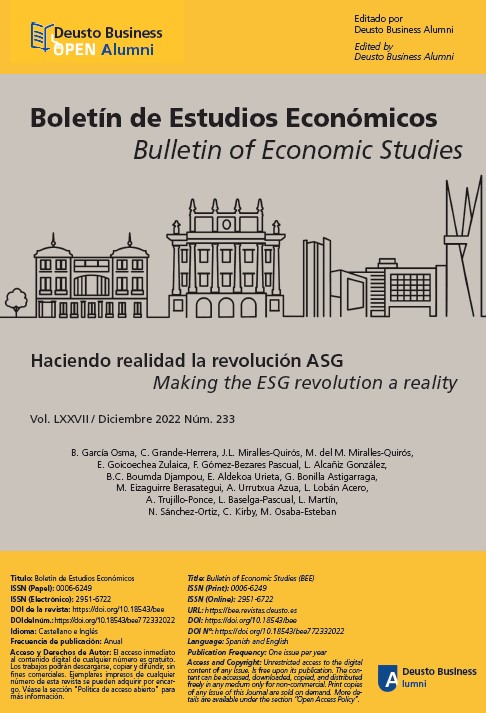Socially responsible investment: economic and psychological aspects of mutual funds management
Abstract
Data provided by both national and international organizations reveal the growing interest of individual investors in Sustainable and Responsible Investment (SRI) funds. Although they seek positive returns, these investors also expect these funds to invest in assets that meet Environmental, Social, and corporate Governance (ESG) criteria. These criteria impose a clear constraint on the strategies that SRI fund managers can pursue. Does the dual financial and ethical objective imply a distinctive behaviour by SRI fund managers? The main purpose of this article is to provide an economic and psychological view of SRI. Based on the literature review, we analyse whether there are differences in performance between conventional and SRI funds and investigate the relationship between performance and cash flow and the existence of the disposition effect in SRI, in order to provide managers and investors with a global view for their financial decision making.
Received: 06 July 2022
Accepted: 21 July 2022
References
An, L., Engelberg, J., Henriksson, M., Wang, B., & Williams, J. (2019). The portfolio-driven disposition effect. Working Paper, Available at SSRN 3126997 https://papers.ssrn.com/sol3/papers.cfm?abstract_id=3126997
Andreu, L., Ortiz, C., & Sarto, J. L. (2020). Disposition effect in fund managers. Fund and stock-specific factors and the upshot for investors. Journal of Economic Behavior & Organization, 176, 253-268.
Arefeen, S., & Shimada, K. (2020). Performance and Resilience of socially responsable investing (SRI) and conventional funds during different shocks in 2016: evidence from Japan. Sustainability, 12(2), 540.
Bauer, R., Koedijk, K., & Otten, R. (2005). International evidence on ethical mutual fund performance and investment style. Journal of Banking & Finance, 29(7), 1751-1767.
Benson, K. L., Brailsford, T. J., & Humphrey, J. E. (2006). Do socially responsable fund managers really invest differently? Journal of Business Ethics, 65(4), 337-357.
Benson, K. L., & Humphrey, J. E. (2008). Socially responsible investment funds: Investor reaction to current and past returns. Journal of Banking & Finance, 32(9), 1850-1859.
Bollen, N. P. (2007). Mutual fund attributes and investor behavior. Journal of Financial and Quantitative Analysis, 683-708.
Boumda, B., Duxbury, D., Ortiz, C., & Vicente, L. (2021). Do Socially Responsible Investment Funds Sell Losses and Ride Gains? The Disposition Effect in SRI Funds. Sustainability, 13(15), 8142.
Capelle-Blancard, G., & Monjon, S. (2014). The performance of socially responsable funds: Does the screening process matter? European Financial Management, 20(3), 494-520.
Cici, G. (2012). The prevalence of the disposition effect in mutual funds’ trades. Journal of Financial and Quantitative Analysis, 47(4), 795-820.
Chevalier, J., & Ellison, G. (1997). Risk taking by mutual funds as a response to incentives. Journal of Political Economy, 105(6), 1167-1200.
Choi, S. H., & Chhabria, M. (2013). Window dressing in mutual fund portfolios: fact or fiction? Journal of Financial Regulation and Compliance, 21(2), 136-149.
Cortez, M. C., Silva, F., & Areal, N. (2009). The Performance of European Socially Responsible Funds. Journal of Business Ethics, 87(4), 573–588.
Curtis, Q., Fisch, J., & Robertson, A. Z. (2021). Do ESG mutual funds deliver on their promises? Michigan Law Review, 120, 393-450.
DeBondt, W., Forbes, W., Hamalainen, P., & Muradoglu, Y. G. (2010). What can behavioural finance teach us about finance? Qualitative Research in Financial Markets, 2(1), 29-36.
Durán-Santomil, P., Otero-González, L., Correia-Domingues, R. H., & Reboredo, J. C. (2019). Does sustainability score impact mutual fund performance? Sustainability, 11(10), 2972.
Eurosif (2018). European SRI Study – Eurosif 2018. Brussels.
Fernández-Izquierdo, M. A., Muñoz-Torres, M. J., Escrig-Olmedo, E., Rivera-Lirio, J. M., & Ferrero-Ferrero, I. (2018). Las agencias de calificación de la sostenibilidad, impulsoras de la inversión socialmente responsable. Boletín de Estudios Económicos, 73(224), 367-385.
Ferreira, M. A., Keswani, A., Miguel, A. F., & Ramos, S. B. (2012). The flow-performance relationship around the world. Journal of Banking & Finance, 36(6), 1759-1780.
Gil-Bazo, J., Ruiz-Verdú, P., & Santos, A. A. (2010). The performance of socially responsible mutual funds: The role of fees and management companies. Journal of Business Ethics, 94(2), 243-263.
Global Sustainable Investment alliance. (2018). Global Sustainable Investment Review 2018. http://www.gsi-alliance.org/wp-content/uploads/2019/06/GSIR_Review2018F.pdf
Humphrey, J. E., Warren, G. J., & Boon, J. (2016). What is different about socially responsable funds? A holdings-based analysis. Journal of Business Ethics, 138(2), 263-277.
Hung, P. H., Lien, D., & Kuo, M. S. (2020). Window dressing in equity mutual funds. The Quarterly Review of Economics and Finance, 78, 338-354.
Kahneman, D., & Tversky, A. (1979). Prospect Theory: An Analysis of Decision under Risk. Econometrica, 47(2), 263-292.
Kempf, A., & Osthoff, P. (2007). The effect of socially responsible investing on portfolio performance. European Financial Management, 13(5), 908-922.
Kempf, A., & Osthoff, P. (2008). SRI funds: Nomen est omen. Journal of Business Finance & Accounting, 35(9-10), 1276-1294.
Leal, C. C., Armada, M. J. R., & Duque, J. C. (2010). Are all individual investors equally prone to the disposition effect all the time? New evidence from a small market. Frontiers in Finance and Economics, 7(2), 38-68.
Lean, H. H., Ang, W.R., & Smyth, R. (2015). Performance and performance persistence of socially responsible investment funds in Europe and North America.
Markowitz, H. (1952). The utility of wealth. Journal of political Economy, 60(2), 151-158.
Marques, M. R., Sampaio, J. O., & Silva, V. A. B. (2019). Window dressing in Brazilian investment funds. Revista Contabilidade & Finanças, 31, 116-128.
Muñoz, F., Ortiz, C., & Vicente, L. (2022). Ethical Window Dressing: SRI Funds are as Good as their Word. Finance Research Letters, 49, 103109.
Nofsinger, J., & Varma, A. (2014). Socially responsible funds and market crises. Journal of Banking & Finance, 48, 180-193.
Ortiz, C., Ramírez, G., & Sarto, J. L. (2013). Assessment of window dressing using fund returns and portfolio holdings. The Spanish Review of Financial Economics, 11(2), 85-93.
Paluzie, A. P. (2020). Origen, desarrollo y futuro de las inversiones socialmente responsables (ISR). Revista Española de Capital Riesgo, (2), 39-58.
Renneboog, L., Ter Horst, J., & Zhang, C. (2008). Socially responsible investments: Institutional aspects, performance, and investor behavior. Journal of Banking & Finance, 32(9), 1723-1742.
Renneboog, L., Ter Horst, J., & Zhang, C. (2011). Is ethical money financially smart? Nonfinancial attributes and money flows of socially responsible investment funds. Journal of Financial Intermediation, 20(4), 562-588.
Riedl, A., & Smeets, P. (2017). Why do investors hold socially responsible mutual funds? The Journal of Finance, 72(6), 2505-2550.
Rudd, A. (1981). Social Responsibility and Portfolio Performance. California Management Review, 23(4), 55–61.
Schueth, S. (2003). Socially responsible investing in the United States. Journal of business ethics, 43(3), 189-194.
Schwartz, M. S. (2003). The” ethics” of ethical investing. Journal of business ethics, 43(3), 195-213.
Sharpe, W. F. (1964). Capital asset prices: A theory of market equilibrium under conditions of risk. The journal of finance, 19(3), 425-442.
Shefrin, H., & Statman, M. (1985). The disposition to sell winners too early and ride losers too long: Theory and evidence. The Journal of Finance, 40(3), 777-790.
Sirri, E. R., & Tufano, P. (1998). Costly search and mutual fund flows. The Journal of Finance, 53(5), 1589-1622.
Spainsif (2021). La inversión sostenible y responsable en España – Estudio Spainsif 2021. Madrid.
Summers, B., & Duxbury, D. (2012). Decision-dependent emotions and behavioral anomalies. Organizational Behavior and Human Decision Processes, 118(2), 226-238.
Viviers, S., & Eccles, N. S. (2012). 35 years of socially responsible investing (SRI) research-general trends over time. South African Journal of Business Management, 43(4), 1-16.
License:
Works published in this journal are available since 2021 under the Creative Commons Attribution-NonCommercial 4.0 International license - CC BY-NC 4.0. Content prior to 2021 is not covered by the journal's current Open Access policy.
Authors' Rights:
Authors retain copyright over their work published in the Bulletin of Economic Studies and grant the Bulletin of Economic Studies non-exclusive rights to exploit the work for layout, publication, and dissemination purposes. This license allows the Bulletin of Economic Studies to distribute, reproduce, and disseminate the work on its platform and through other media, subject to the conditions outlined in this notice.
Readers' Rights:
Readers may read, download, print, search, share (copy, redistribute, or link to full text), or adapt (remix, transform, and build upon the material) the content, provided that:
- The materials are not used for commercial purposes.
- The original work is properly cited, including the name of the author and the source.
- Any modifications made to the original content are clearly indicated.
Commercial use of the materials is prohibited without the express permission of the authors. For clarity, commercial use is defined as any activity intended for financial gain or involving direct commercial exchange.
Conditions of Use:
The use of content must not infringe the rights of others or be used in a way that could damage the reputation of the author or the Bulletin of Economic Studies.
Responsibility for Content:
Authors are responsible for the content of their papers and the Bulletin of Economic Studies is not responsible for the opinions therein expressed.
More Information:
Open Access, Licensing, and Copyright Policy


.jpg)
.jpg)
.jpg)








